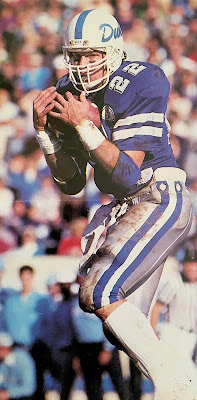Dear Ironman:
I've thoroughly enjoyed the five Ironman events I've completed. From Boulder to Lake
Placid to Mont-Tremblant, the events were well-organized and well-run, making for a truly
memorable experience.
There's not much you can do about the pain one endures over the course of an 140-mile event,
but when it's all said and done, there is nothing quite like hearing Mike Reilly say, "You are
an Ironman" as competitors cross the finish line. It's a nice touch for an incredible event.
However, I really believe there is one thing the Ironman can do without: calling the bags
we use during the race "special needs" ones. Whenever I hear volunteers at check-in say,
"These are your "special needs bags", I cringe. It just doesn't sound right. In fact, it sounds
awful. The "special needs" bags in an Ironman event are used by competitors to put their
'goodies' in to help them get through the race. Power Bars, gels, goos, Swedish fish, aspirin,
band-aids, socks, Vaseline, sandwiches - if it can get a competitor through the endurance race,
chances are it will be in the "special needs" bag.
When I hear "special needs", I think about what most people do: those special kids who are
sometimes referred to as ones with "special needs." They are ones who need a little (or a lot) of
help just to get through the day.
Wikipedia defines special needs as people with autism, cerebral palsy, down syndrome,
dyslexia, blindness, ADHD, and cystic fibrosis. However, there are a lot of children born
with many other things that make them children with special needs.
When I hear someone talk about those "special needs" bags at an Ironman event, I feel
uncomfortable. If I was a parent of a child with special needs, I would certainly find it, um,
awkward, if not offensive. It's just not right and I think the Ironman franchise should find
a way to change the name of the bags. Call them Fuel and Recovery bags, but please don't
call them "special needs" bags. Call them S.O.S bags - anything but 'special needs' bags.
Major League Baseball recently made a big change when it came to how they described
the list where injured players land. Almost since its inception, baseball had a "disabled list."
Because of their sensitivity to others, it will simply be called the "injured list"
"The principal concern is that using the term "disabled for players who are injured supports the
misconception that people with disabilities are injured and therefore not able to participate or
compete in sports," said Jeff Pfeifer, MLB's senior director of league economics and operations.
Despite the change being long overdue, it was a great move by Major League Baseball.
There is nothing special about those bags, But there is certainly a lot that is special about
the kids who have to overcome a lot just to get through the day. Same goes for the parents.
It is extremely tough, both mentally and physically, for the parents and kids with 'special
needs' to deal with the cards they've been dealt. It's heart-wrenching for those who watch
them try to overcome the challenges they face every single day, 24/7.
When I'm swimming 2.4 miles in a beautiful lake or riding 112-miles on courses with
spectacular scenery, I find myself counting my blessing on just how lucky I am to compete
in an Ironman event, especially in my mid-50's. I am thankful that I'm able to run, bike, and
swim and enjoy everything an Ironman event has to offer.
I just don't like to see "special needs" slapped across the bags that contain fuel and
recovery items. I don't think it qualifies as being in good taste. Competitors really are not
special. Special should be used on those kids who didn't have luck on their side when they
came into this world. They are the ones who have incredible character and tremendous will.
The "special needs" bags need to go away in the Ironman events. Call them Fuel and Recovery
bags. The "special" part needs to always be used when describing those special little kids.
Thank you.
Paul Devlin


































